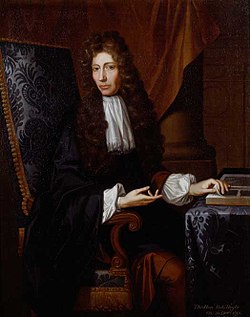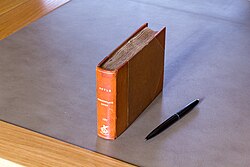Robert Boyle
Robert Boyle FRS (25 January 1627 – 31 December 1691) was a 17th-century natural philosopher, chemist, physicist, inventor and founding member of the Royal Society.
Robert Boyle | |
|---|---|
 Robert Boyle (1627–91) | |
| Born | 25 January 1627 |
| Died | 31 December 1691 (aged 64) |
| Known for | Boyle's law, founder of modern chemistry |
| Awards | Fellow of the Royal Society |
| Scientific career | |
| Fields | Physics, chemistry |
| Influences | Robert Carew, Galileo Galilei, Otto von Guericke, Francis Bacon |
| Influenced | Considered the founder of modern chemistry |
Boyle was born in Ireland to a titled Anglo-Irish family. He was the fourteenth child of Richard Boyle, 1st Earl of Cork, who had arrived in Ireland in 1588.
Career
Robert Boyle is best known for Boyle's law.[1][2]
When Robert Hooke was young, Boyle employed him as an instrument-maker and assistant. They continued to cooperate when Hooke took charge of experiments at the Royal Society.
Scientific research was the main focus of Boyle's life. He joined other like-minded men in a group which called itself the "Invisible College".[3] He was part of the group which founded the Royal Society in 1660.[4]
Boyle was an alchemist, but also the first modern chemist. His 1661 book, The Sceptical Chymist, is important in the history of chemistry.
Religious interests
As a director of the East India Company Boyle spent large sums in promoting the spread of Christianity in the East. He contributed liberally to missionary societies and to the expenses of translating the Bible or portions of it into various languages.
Boyle supported the policy that the Bible should be available in the language of the people, in contrast to the Latin-only policy of the Roman Catholic Church at the time.
Robert Boyle Media
Sculpture of a young boy, thought to be Boyle, on his parents' monument in St Patrick's Cathedral, Dublin.
One of Robert Boyle's notebooks (1690–1691) held by the Royal Society of London. The Royal Society archives holds 46 volumes of philosophical, scientific and theological papers by Boyle and seven volumes of his correspondence.
Plaque at the site of Boyle and Hooke's experiments in Oxford
Fig. 3: Illustration of Excerptum ex collectionibus philosophicis anglicis... novum genus lampadis à Rob. Boyle ... published in Acta Eruditorum, 1682
Statue of Boyle in Lismore, County Waterford, Ireland
References
- ↑ Boyle's Law describes the inverse relationship between the absolute pressure and volume of a gas.
- ↑ Acott, Chris (1999). "The diving "Law-ers": A brief resume of their lives". South Pacific Underwater Medicine Society Journal. 29 (1). ISSN 0813-1988. OCLC 16986801. Archived from the original on 2011-04-02. Retrieved 2009-04-17.
- ↑ Kassell, Lauren. "Invisible College (act. 1646-1647)," Oxford Dictionary of National Biography
- ↑ "Robert Boyle’s astonishing scientific wishlist," The Royal Society: 350 Years of Science (exhibition). June 2010.
Further reading
- Hunter, Michael. (2000). Robert Boyle, 1627-91: scrupulosity and science. Woodbridge: Boydell & Brewer. ISBN 9780851157986; OCLC 185478148
- __________. 2009. Boyle: between God and science. New Haven: Yale University Press. ISBN 9780300123814; OCLC 698916661








